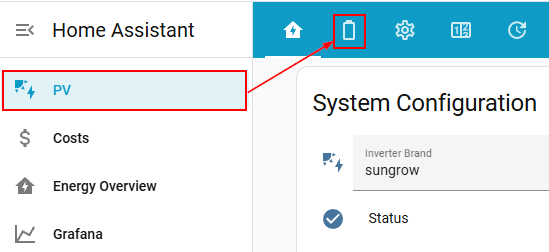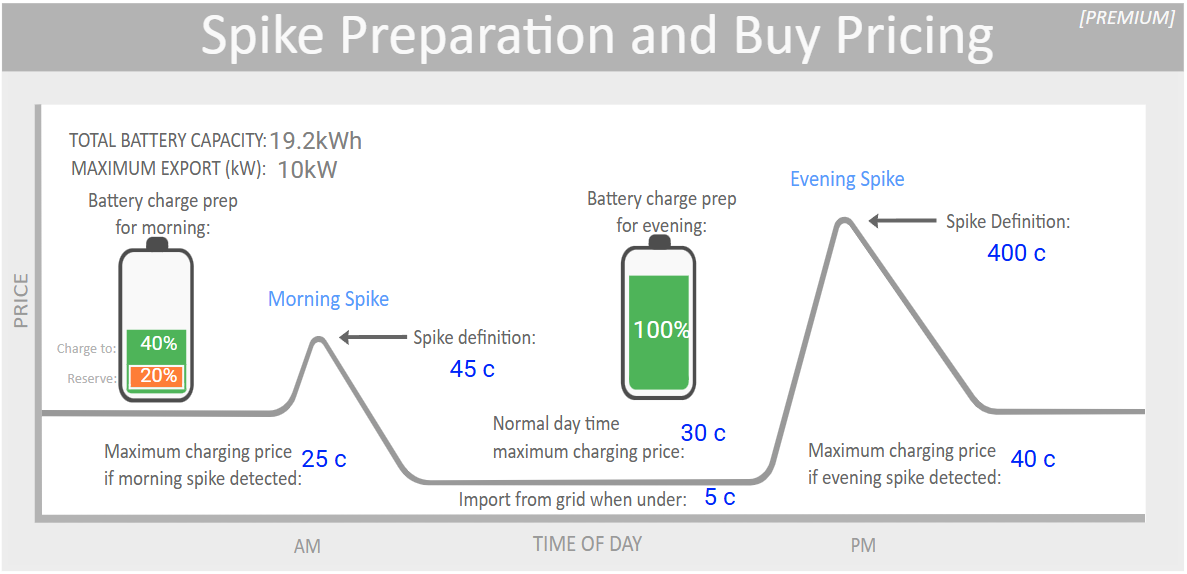Energy Manager Settings
The settings that have come with the Energy Manager backup restoration may or may not be suitable for you. Whether they will be suitable for you will completely depend on your solar generation, your battery storage capacity, and your power consumption patterns.
Start with these defaults, but pay attention to how Energy Manager works for the first few weeks, as you will most likely have to tweak them to suit you. It will learn your power consumption pattern over time, and should have a good idea of your typical usage pattern over the first couple of weeks. The usage pattern will adjust along with your changed patterns during different seasons.
Energy Manager Settings Page
Select the PV menu on the left menu. Then click on the battery icon on the top tab.

The page that will be displayed consists of four sections and is the main location for controlling the decisions that Energy Manager will make:
- Spike Preparation and Buy Pricing
- Normal Mode
- High Sell Mode
- Weather Settings
Details of the Spike Preparation and Buy Pricing section and how to configure it are detailed in this section.
Spike Preparation and Buy Pricing
The first section, as below, allows you to control when to charge your battery in preparation for price spikes, and what your own 'definition' of a price spike is. All figures on the chart are configurable from here.

- Total Battery Capacity - This figure is taken from the Energy Manager settings page, but can also be updated here.
- Maximum Export - this is how much you're allowed to export per kW, as dictated by your energy distributor (not your energy provider like Amber Electric or LocalVolts). It is configured during the installation by yourself, but you should set it once and forget it.
- Battery charge prep for morning (left battery capacity, set at 40% and 20% in the image) - if there is an upcoming morning spike predicted, to what percentage do you want your battery charged in preparation, and what should it discharge to? Normally you would set this to be something quite low, just enough to both export and make some profit, and to keep your house off the grid until the sun comes up. If you charge it too much, it will be a waste as you will probably generate power in the upcoming hours, so don't need it stored. Morning spikes aren't very usual, and they don't generally peak as high, or last as long, as evening spikes. In this example, it is configured to charge your battery up to 40% of its capacity, and will discharge (if appropriate) until it reaches 20% capacity. The reserve (in orange) is for your use to get you through the morning spike without taking from the grid for your own use.
- Spike definition (morning) - at what sell price is a morning spike defined? If the highest morning sell price is predicted to be below this, no charging will occur. If it is predicted to be higher than this, then it deems a spike to be predicted. In the image, it is set at 45c. This means that if a predicted spike of 50c was detected, it would charge the battery to 40% (as per the image) in preparation. If the spike prediction never occurred, you would use this charge yourself and it would take up battery capacity that may be better kept for solar generation during the coming day. So it's a fine balance of how you should configure this.
- Maximum charging price if morning spike detected - this is how much you're willing to pay to charge your battery, should an upcoming morning spike be detected. In this example, if a spike was detected (a sell price of over 45c), then the battery would be charged up to 40%, but only if the current buy price was 25c or under. If the definition of a spike is not met, then Energy Manager will simply continue with its normal operation (of supplying the house power from the battery, as it is probably not high solar generation, if at all, at this time).
- Battery charge prep for evening (right battery capacity, set at 100% in the image) - if there is an upcoming evening spike predicted, to what percentage do you want your battery charged in preparation? The recommendation is ALWAYS leave this at 100%. Why would you not want to have your battery full by the time it starts to get dark anyway, whether there is a spike predicted or not?
- Spike definition (evening) - at what sell price is an evening spike defined? If the highest evening sell price is predicted to be below this, no additional charging will occur. Note that Energy Manager will always try to have your battery at full 100% charge capacity before the demand period (or 4pm) occurs, and if the price will be under this amount (in the image 400c), it will still charge up to 100%, as long as the "typical pre-evening max charge cost/kWh" price is met (see below).
- Normal day time maximum charging price - Energy Manager will always attempt to have your battery at full 100% capacity before the evening (and demand period) starts. The "Normal day time maximum charging price" is the highest amount per kWh that you are prepared to pay to charge your battery. Note: If you set this figure too low there may not be any opportunity for Energy Manager to charge your battery to make up the shortfall on a low generation day, so keep this realistic. This is NOT the price you are prepared to pay to charge up your battery in preparation for a price spike.
- Maximum charging price if evening spike detected - this is how much you're willing to pay to charge your battery, should an upcoming evening spike be detected. In this example, if a spike was detected (a sell price of over 400c, or $4), then the battery would be charged up to 100%, but only if the current buy price was 40c or under. If the definition of a spike is not met, then Energy Manager will simply continue with its normal operation (of supplying the house power from the battery, as it is after the sun will have gone down, so no solar generation, at this time).
- Import from grid when under - if there is a shortfall between what your solar is generating and what your house load requires, Energy Manager will import from the grid if the buy price is less than this price. Sometimes it is best to import from the grid rather than discharge from your battery to make up the shortfall. There is a cost associated with discharging your battery, in that you are introducing wear and tear on a finite number of charge/discharge cycles. In this example, should the solar system not be able to supply enough power to cover the current house load, then as long as the buy price was under 5c/kWh, the preference is to import from the grid. Note, this will not occur during a demand period (not that the price would ever be cheap then anyway).
Energy Manager is designed to stop importing from the grid, if it was, before the demand period starts. Demand periods have an extra charge on them that is multiplied throughout the whole month, and you do not want to import anything during these periods if you can help it.
You can go directly to the other sections of this configuration page below:
➜ Weather Dependent Discharge Settings